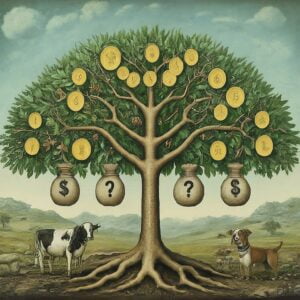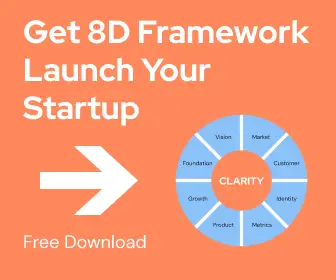Just so you know, we’re not going to teach you to be a stuck-up nerd who can’t even decide what to eat without a spreadsheet full of data.
However, if you want to run a successful business – you will have to get comfortable with analyzing metrics.
We don’t want you to be a complete nerd, but we also don’t want you to be whatever this is…
Only relying on vibes can lead you to make impulsive and irrational decisions that are NOT grounded in reality. Don’t get me wrong, gut instinct is a great thing – but you have to pay attention to the data.
When you understand your data, you’ll be able to tweak things and consistently get better and more high-paying customers.
This is beautifully summarized by this slogan phrase: “Business begins where slogans end and numbers appear.” While passion and vision are important in the initial stages, sustainable growth requires a deep understanding of key metrics and unit economics.
That’s why we use Unit Economics. I know it sounds difficult and scary, but it’s really the simplest thing about your business. Let me explain…
What Even is Unit Economics?
Rest assured, even though the term has the word ECONOMICS inside, it’s really easy to understand.
So.. Ahem… 🤓…
Unit economics represents the granular decomposition of a business’s financial architect–
HA! GOT YOU THERE!!
Now, for the easy definition…
Unit economics is the basic thing that a business sells. It can be a product, a service, a subscription…
Basically, it explains the product and the INTERACTION between the product and the customer.
Think about it, doing business isn’t just about producing something for as little as possible and selling it for a higher price. You also need to factor in the marketing, the usage of the product, the customer’s loyalty, churn…

Examples to Make Unit Economics Extremely Easy to Grasp
Let me give you a couple of examples to make it all crystal clear.
For e-commerce businesses: The unit is literally just one product sold. But we’re not just looking at the price tag and the cost, we’re also looking at what it costs to bring that customer in, the profit from that sale, and how likely it is that the customer will come back to buy more.
For a SaaS company: A subscription. Ask yourself – how much did it cost to acquire that customer? How profitable is the subscription? How long will the customer stay? How much will the customer bring you over their lifetime? When are they most likely to leave? HAVE YOU THOUGHT OF THESE THINGS? HA? No worries if you haven’t 🙂
I think these two examples should be enough for you to understand that nowadays, you can’t just calculate the price tag minus the cost of production and call it a day. There are other important things, like loyalty, churn, velocity, and a lot of other beautiful metrics…
We’re not going to talk about all of them, as we do sell a course about Unit Economics. If you want to understand how to make decisions based on every important startup metric, check it out here.
This is just a teaser for the course 😉.
The Customer Journey: Learn to Read Your Customers’ Minds
We have an in-depth article about it already, but let me briefly explain it in the context of unit economics.
In most startups, a “unit” is just one user – so it would make sense to understand what goes through their minds at every single moment, right?
You have to know what your unit (user) needs in order to become your customer. From seeing you dance on TikTok, to opting in your email list, to checking out your sales page, to buying your product, to referring your product to others…
If you know what goes through people’s minds at each step of the funnel, you win.
Customer Acquisition: A Very Simple Definition
This is the part that most startups/new businesses struggle with. If you don’t know what it is…
Customer acquisition is the process of… Well, acquiring a customer 🙂! When you nail your customer acquisition process, you have a perfectly oiled machine that can get you new customers on autopilot.
The most important metric when it comes to customer acquisition is Customer Acquisition Cost (CAC). I told you a lot of this stuff would be very straightforward!
Basically, you want to make more from one customer than you spend to acquire them. To do that, the customer journey map comes in clutch (again).
A common misconception among rookie entrepreneurs is that a great product automatically guarantees success. Newsflash: you also need a viable business model, customer acquisition strategies, and a deep understanding of unit economics.
There are multiple metrics to help you achieve this. Let me show you…
Conversion Rates: Track How Well Your Funnel Works
We use conversion rates to gauge how effectively users move through our sales and marketing funnels.
Your funnel has steps (hopefully). Every step of the funnel should lead a good amount of people to the next step. What you have to do is tweak every single step and track the conversion rate.

Let’s say you’re sending cold emails to potential clients. This is what should go through your head:
“Are they getting opened? No, your subject line sucks! Okay, let’s write a better one. Are people responding to my email or does absolutely nobody give a sh*t about what I have to say? Ooookay, it’s the latter, so let me tweak my email copy. Now that I’ve fixed that, are my terrible sales skills costing me sales? Great, gotta work on those too.”
Yes, it takes time, effort, and a lot of thought to optimize your CRs, but once you do, you’ve hit the jackpot.
If you want to learn how to calculate CRs and get a perfectly-oiled machine that will get you customers on autopilot, check out the Unit Economics course.
Lifetime Value (LTV): Not How Much Someone’s Life is Worth to You
Come on, it’s not the 14th century. LTV is about how much money a customer brings you over their lifetime by buying your products.
You want to track this so you can know how much recurring revenue you can count on. Businesses LOVE recurring revenue because it’s predictable. If you have a solid base of loyal customers, you’ll have a steady income to rely on.
The more a customer is worth to you, the more you can spend to acquire them. Let’s say you’re selling a product worth $40 and it costs $50 on average to acquire a customer. If the LTV is higher than $50, acquiring that customer can still be worth it. That’s the point of LTV.
Getting the highest possible LTV goes much deeper than this article, but you can read more about it here.
Churn Rate: WHY DID YOU LEAVE ME?!
Understanding your churn rate is basically understanding why your exes left you, but the exes are your customers. Sounds pretty important to me…
The churn rate is the rate and time period at which customers stop using your service or product. This happens to every business, but the rate can vary.
So, welcome to Business Therapy 101. It’s time to look inward to understand what makes your customers leave. This way, you can improve and have more loyal customers.
Sometimes people churn because they simply give up on using your product. While you can’t control people’s motivation, you can understand when people seem to churn most and give them incentives to keep buying from you.
If you want to understand why and when people tend to churn and exactly what to do about it, you guessed it…
Check out the Unit Economics Course.
Retention: The Other Side of Churning
You might have heard the cliché, but true phrase: “It costs more to get a new customer than to retain existing ones.”
Retention is often overlooked in the early startup hustles, but let me tell you, it’s REALLY important. If you only focus on sales, you won’t get too far.
As an entrepreneur, you HAVE to focus on keeping those hard-earned customers coming back for more. Usually, the happier the customers are, the healthier your business is.
If customers are coming back time and time again, it means you’re providing exceptional value AND building trust… and trust is the foundation of every relationship!
Variable costs: Calculate the Basic Stuff
Variable costs cover everything you spend to produce one unit of product or deliver one unit of service. Basically it’s stuff like paying for materials, rent, freelancers, paying tax evasion fines…
When you calculate your income and your expenses, you can see the famous profit margins!
We recommend having the biggest possible profit margins, while still giving people good deals. That’s the sweet spot.
How to Use All These Metrics to Make Data-Driven Decisions
Honestly, it’s just constant improvement, improvement, and some more improvement. That said, collecting data for data’s sake, without a clear plan, is just a waste of time. Not all metrics are equally important.
Far too many business owners make the mistake of making decisions without having the data to back them up. Think of yourself as a scientist making decisions based on empirical evidence.

Also, tweak one thing at a time, so you clearly see what makes a metric go up or down. If you tweak a lot of stuff simultaneously, you’ll have no idea what actually provoked a change.
And don’t just look at your metrics as numbers. See them as indicators of how well your strategies align with your vision. Ask yourself “What are my goals?” and see if your numbers align with them. That’s how you know you’re on the right path.
Remember, all of this takes a lot of time and effort.
It’s not a sprint, it’s a marathon…
I almost vomited while saying that, but you get the point.
There are many more ways to use these metrics – and there are more useful metrics we haven’t talked about here, like velocity and in-depth churn metrics. We talk about all of them in the Unit Economics course, which will help you understand every single important metric in your business. Inside, you’ll also find examples from a real-life dance studio to bring all those “boring” metrics to life.
Takeaways
Unit economics is the basic thing that a business sells. It can be a product, a service, a subscription, etc. If you want to grow your business and you only track profits and costs, you’ll be very limited. Here are the main metrics from this article that you can track:
- Customer Acquisition Cost (How much it costs to acquire one customer)
- Conversion Rates (How well does one step of the funnel lead people into the next step)
- Lifetime Value (How much $$$ one customer, on average, brings you over their lifetime)
- Churn Rate (How many customers stop buying from you after a certain point)
- Retention (How many customers buy from you time and time again)
- Variable Cost (How much money it costs you to produce your product)
When you take all of these metrics into account (and more from the course), you’ll be able to correctly estimate how good your product is on a unit level – and make it as profitable as possible.








